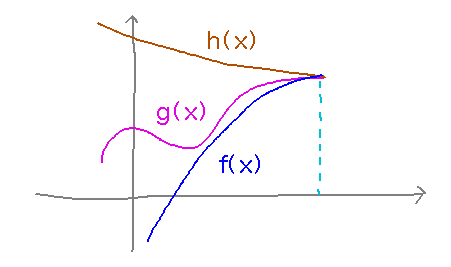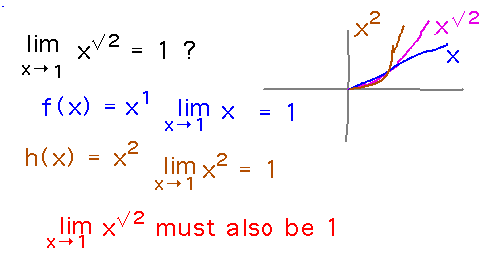
SUNY Geneseo Department of Mathematics
Friday, September 15
Math 221 05
Fall 2017
Prof. Doug Baldwin
Presented by the Math Learning Center
Wednesday, September 20, 2:30 PM
Welles 26
Problem set questions that ask for “proofs” about limits should use epsilon/delta proofs, as in yesterday’s class.
Consider the equation F = G m1m2 / r2
As r approaches 0, this approaches ∞, so the actual values of G, m1, and m2 don’t matter as long as they’re constant
Use limit laws or algebra to get the answer rigorously.
But a table of values, or the graph the question asks for, can be good ways to guess what the laws and algebra should be used to show.
Subsection “The Squeeze Theorem” of section 2.3
Example. Use the squeeze theorem to show that limx→1x√2 = 1.
Reading ideas: Even the theorem itself isn’t clear.
A visual explanation:

Take-Away. if function g lies between functions f and h, and f and h have the same limit at some point, then since g lies between them it must have that limit at that point too.
Here’s how to use this idea to show that limx→1x√2 = 1:

As a technical point, the book states the theorem in a way that requires f(x) ≤ h(x) at all points in some interval around a (the x value you want the limit at). This means the graphs of f(x) and h(x) can’t cross at a, although in practical cases they often do. To handle this really right you should separately use squeezing to show a limit as x approaches a from below, and a limit as x approaches a from above, switching the roles of f and h in the two squeezes. Assuming the 1-sided limits are equal, use that fact to conclude that the 2-sided limit(s) are also all equal.
The squeeze theorem is a valuable tool for evaluating limits such as of trigonometric functions that don’t lend themselves to formal evaluation by the methods we’ve seen so far.
Example. Finish the proof that limx→0 sinΘ/Θ = 1 by filling in the details behind the “By applying a manipulation similar...” sentence.
It’s not clear what’s going on in that proof either. Especially what role the unit circle plays, and where the original inequality whose parts all get divided by sinΘ is.
Here are some explanations, with reference to the unit circle diagrams in the text (e.g., Figures 2.29 or 2.30):
Introduction to derivatives.
Read section 3.1.